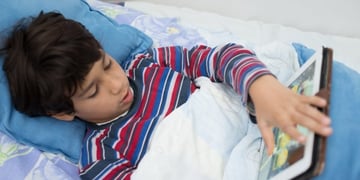What's Next in Hospital Patient Entertainment Systems?
5 minute read | 07/10/2019

When hospitals started to offer television in the early 2000s, the government saw it as a triumphant drive towards ‘patient power.’ Although it was back then, technology has significantly evolved and hospital patient entertainment systems need to as well.
Here’s how the NHS has successfully has moved away from outdated legacy systems and what the future holds.
- What Did Hospitals Have Before?
- What Should Hospitals Have Now?
- What’s Good About a Modern Patient Entertainment System?
What Did Hospitals Have Before?
Before 2005, patients were lucky to get a little TV set placed above their head. There would also be a telephone on the nightstand to communicate with loved ones and a radio to listen to music. It was the only source of entertainment, but it was acceptable.
From 2005 onwards, hospitals started to roll out the systems we’re familiar with today. The screens attached to bedframes via an ‘arm’ allowed systems to be pulled towards the patient as they sit or lie in bed. Although, they weren’t user-friendly.
At the time, this was a great idea. But technology has rapidly advanced at the same time as NHS staff's needs, meaning legacy systems couldn’t keep up. Plus, they were bulky and had poor quality built-in screens. For instance, patients had to pay up to £10 a day to watch TV and long stays in hospitals meant this could easily add up to be expensive.
What Should Hospitals Have Now?
Following cuts, NHS Trusts began to look for cost-effective and user-friendly alternatives. Sadly, most hospitals still have bulky legacy systems which are 10 years out of date. The best approach for Trusts is to implement a proper patient entertainment solution, like SPARK® Media. Learn more about how we became the NHS’s most respected provider here.
Solutions like this allow patients to stream live TV, movies and music thanks to apps accessed via a device or the web browser (which can be the patient’s own or the hospital’s). This is more streamlined and user-friendly than the old legacy systems.
What’s Good About a Modern Patient Entertainment System?
This innovative approach to patient entertainment puts the patient first and helps improve NHS staff efficiency in a number of ways. These include:
- Allows vital information to be easily accessed by both staff and patients.
- Entertains patients and improves the hospital experience.
- Helps Trusts manage their resources better.
- Prevents ad-hoc patient requests from interrupting staff.
- Allows more opportunities for feedback.
Allows Vital Information to Be Easily Accessed by Both Staff and Patients
Modern patient entertainment systems feature vital information, such as medical care details or checking appointments. This means hospital staff won’t be bombarded with ad-hoc queries and patients can find out information instantly.
They no longer need to wait for someone to be free to help them.
Entertains Patients and Improves the Hospital Experience
A hospital stay can be an isolating experience with patients feeling detached from the outside world due to visiting hours dictating when their loved ones can visit. Many hospitals’ poor cellular signal also makes it difficult to keep in touch with friends and family.
WiFi allows patients to make video calls, send emails, instant chats and more - just like they would at home. But patient entertainment systems improve this further. A proper system provides entertainment and engagement for patients and a clinical platform for staff. So patients can watch TV, stream videos on demand, listen to the radio and more.
Patients can also do this on their own device or one owned by hospitals. This allows for greater entertainment during their hospital stay and boosts their overall experience.
Helps Trusts Manage Their Resources Better
Patient entertainment systems aren’t just aimed at patients. For example, the system can be integrated with a Trust’s meal ordering provider so patients can order meals at the touch of a button. This means staff no longer pass around meal cards. Plus, as the system can be linked to patients and their ward number, the meals can be redirected if they move.
Patients can also easily read electronic menus and be aware of the ingredients before they order. This helps the NHS as it reduces food wastage, especially since it was reported that the NHS wasted £27 million on uneaten food in 12 months.
This occurs because of patients not being aware of dietary contents and when food arrives, they realise they’re allergic and can’t eat it. It also happens as meals are delivered to the wrong beds as patients move between wards, but a modern patient entertainment system with an integrated meal ordering feature prevents this.
Prevents Ad-hoc Patient Requests From Interrupting Staff
Asking for an extra pillow, blanket, a glass of water - NHS staff sometimes have to cater to these ad-hoc patient requests. This can disrupt productivity as they need to stop their existing tasks and tend to a new request. Market-leading patient entertainment systems can have this feature integrated into their platforms so staff aren’t interrupted.
Patients can make service requests which are picked up by the relevant member of staff. This ensures the productivity of other team members isn’t disrupted so the hospital can continue to deliver excellent healthcare.
Allows More Opportunities for Feedback
To improve their services, hospitals need feedback from patients and visitors. The problem is that many people don’t complete these surveys, either because they don’t want to, they ignore the reminders or they simply forget.
Patient entertainment systems can offer integrated opportunities for feedback which are accessed on the platform’s homepage. As it’s clearly displayed on their device, they’re less likely to forget. It’s also more convenient as they can use a device that they’re comfortable with.
To enjoy these benefits, you need to find a system that’s right for your Trust. That’s where our brochure can help.
Revolutionise Your Trust With Patient Entertainment Systems
If you’re interested in finding out how patient entertainment systems have evolved and what modern platforms can do for the NHS, then download a free copy of our SPARK® Media brochure below.
A patient entertainment system can change the way an NHS Trust delivers its healthcare service. If you want a hands-on demo to see it in action for yourself, then why not book your free demo below?
About the author
Rebecca O'Donovan
Becky is the Marketing Director at SPARK TSL, of whom she has worked for since 2012. She is responsible for high-level marketing strategy focusing on lead generation and aiding the vision of the business to ensure business growth.
More articles by the author
Related articles
 Healthcare Industry
Healthcare Industry
What Patient Entertainment Systems Should Be
At its very heart, a patient entertainment system should be about its user - the patient. Personalised care ...
 Healthcare Industry
Healthcare Industry
How Important Are Hospital Patient Entertainment Systems? | SPARK TSL
New, innovative hospital entertainment systems offer patients and staff more than their legacy predecessors ...
 Healthcare Industry
Healthcare Industry
Smarter with Investment in Hospital Entertainment Systems
People Expect it to Boost Their Satisfaction Patients are now more reliant on their own smartphones and ...




